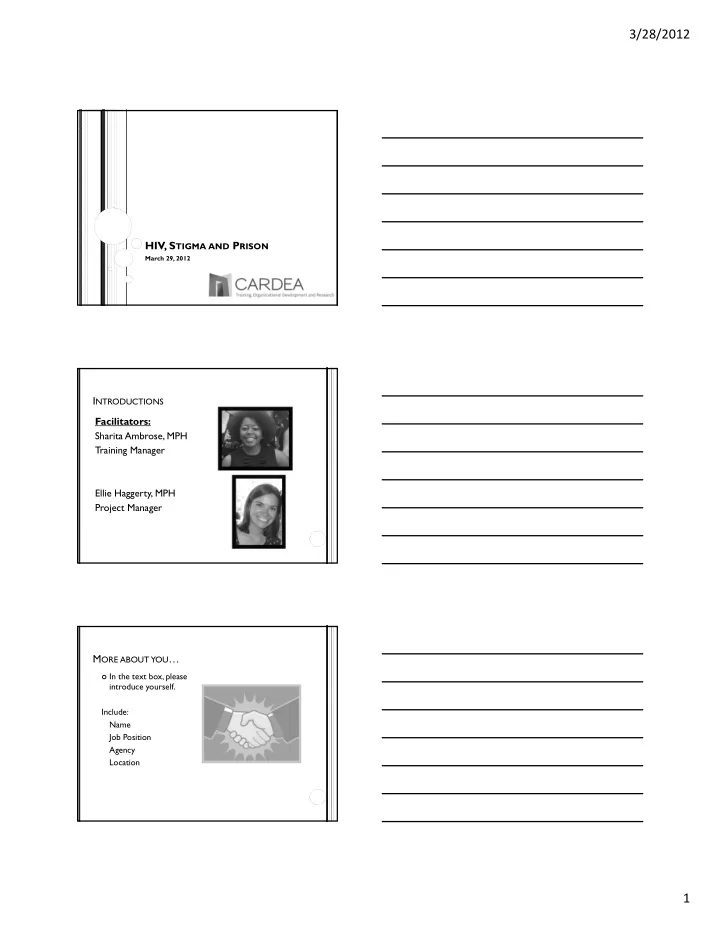

3/28/2012 HIV, S TIGMA AND P RISON March 29, 2012 I NTRODUCTIONS Facilitators: Sharita Ambrose, MPH Training Manager Ellie Haggerty, MPH Project Manager M ORE ABOUT YOU … In the text box, please introduce yourself. Include: Name Job Position Agency Location 1
3/28/2012 OBJECTIVES Discuss common myths and beliefs about people with a history of incarceration and the impact of those beliefs Identify the root causes and factors that lead to HIV/AIDS stigma with incarcerated populations List ways that stigma can affect public health upon reentry to the free world W HAT IS STIGMA ? Branding of a group or individual A. Negative feelings, beliefs and behaviors directed toward B. an individual or group due to a particular label of characteristic A crime when a person targets a victim because of C. their perceived membership to a certain group Unfair treatment of individuals of a particular race, D. ethnic group, gender, religion or other social group based upon prejudice or bias C OMMON B ELIEFS ABOUT I NCARCERATION Inmates are bad people who deserve to be punished / deserve what they get There are career criminals whose imprisonment will reduce crime / once a criminal always a criminal Tougher penalties are needed to protect the public from dangerous criminals / prisons keep the community safe Tougher penalties deter crime 2
3/28/2012 I MPACT OF I NCARCERATION S TIGMA Loss of voting privileges, sometimes permanently Loss of eligibility for federal housing or housing subsidies Loss of eligibility for federally financed student loans Loss of many employment opportunities Increasing rates of poverty and social disadvantage Second-class citizen status Higher risk of homelessness B ARRIERS TO R E -E NTRY B ARRIERS TO R E -E NTRY 3
3/28/2012 B ARRIERS TO R E -E NTRY W HAT IS HIV S TIGMA ? UN AIDS defined HIV stigmatization as a “social process of devaluation that reinforces negative thoughts about persons living with HIV and AIDS.” P OLL Q UESTION What percentage of inmates in state or federal prison are living with HIV or AIDS? 13% A. 1.5% B. 20% C. 55% D. 4
3/28/2012 I NCARCERATION AND HIV In 2008, there were 21,987 inmates in state or federal prisons living with HIV or AIDS (1.5% of total custody population). exas has the 3 rd largest number (2,450) of T inmates living with HIV/AIDS in the country. Prisoners are listed as one of four “major at-risk and neglected populations” (2006 Report on the Global AIDS Epidemic) References: Bureau of justice statistics: HIV in Prison, 2007-2008 HIV T ESTING IN F EDERAL AND S TATE F ACILITIES Federal Mandatory if high risk upon entry Upon Request Exposure Incident Texas Mandatory upon entry (unless already known to be HIV+) Mandatory before release Upon Request Exposure Incident References: T exas T esting practices: http://devel-drupal.law.csuohio.edu/currentstudents/studentorg/jlh/documents/2gPope.pdf HIV T ESTING IN P RISONS Since 2006, the CDC has recommended routine opt- out HIV screening and testing for settings with a prevalence of undiagnosed HIV infection ≥ 0.1% T exas Department of Criminal Justice Year Average # of HIV # of positive HIV AIDS Offender tests HIV tests population population Population 2009 156,088 126,692 603 2,453 838 0.48% of all tests 2% of 1% of were positive inmates had inmates had HIV AIDS References: CDC guidelines http://www.cdc.gov/mmwr/preview/mmwrhtml/mm6024a3.htm?s_cid=mm6024a3_w T exas statistics: http://www.tdcj.state.tx.us/divisions/hs/health_aids_stats.html 5
3/28/2012 T REATMENT FOR HIV+ I NMATES Inmates are the only population with the guaranteed right to health care in the U.S. Facilities are required by law to provide treatment and care to HIV+ inmates Housing Most states prohibit segregation of HIV+ inmates Can be isolated when deemed medically necessary References: Treatment practices: http://devel-drupal.law.csuohio.edu/currentstudents/studentorg/jlh/documents/2gPope.pdf R OOT C AUSES OF HIV STIGMA IN I NCARCERATED POPULATIONS Traditional HIV stigma Power dynamics Mistrust of correctional facility staff Perception of transmission The perception of “going in negative coming out positive” H OMOPHOBIA IN P RISON Inmates have been attacked and killed for being perceived as gay and/or HIV positive in prison. HIV is still largely considered a 'gay disease' inside. If an inmate becomes too interested in treatment or education, he or she may be labeled as gay, adversely impacting health, housing, and life. Incarcerated Populations & HIV AIDS Community Research Initiative of America 6
3/28/2012 I MPACT OF HIV STIGMA WHILE INCARCERATED Fear of discrimination deters inmates from accessing the voluntary HIV testing available in most prisons Fear of stigmatization discourages HIV+ inmates from seeking medical services and treatment Lack of privacy in taking meds complicates antiretroviral therapy C OUNTERING HIV STIGMA WITH I NCARCERATED POPULATIONS Educating inmates and staff about HIV Educating staff and providers to recognize stigma Focusing efforts on re-entry programs Partnering with the criminal justice system Q UESTIONS Thanks for your participation and good luck in your future endeavors! 7
Recommend
More recommend